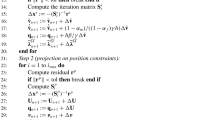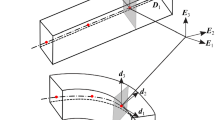Abstract
For computational multibody system dynamics, contact and friction problems are very complex and important problems. Therefore, this paper proposes a novel nonsmooth method for flexible multibody systems with contact and friction in 3D space. Considering the nonsmooth effect of contact and friction on the state variable of the multibody systems, the proposed method is divided into two parts: (i) the change of state variables under the action of smooth force and (ii) the change of state variables caused by contact and friction. Furthermore, for the contact part, the Newton’s impact law and the classical Coulomb friction model are employed to deal with normal impact contact impulse and tangential friction contact impulse, respectively. In addition, Fischer–Burmeister function and Karush–Kuhn–Tucker conditions are also used to solve the normal impact contact impulse and tangential friction contact impulse. What’s more, since the symplectic discrete format performs well robustness to numerical results, the discrete format of the proposed method is based on the symplectic discreteness, and it is expected to obtain the robust numerical results. Finally, several numerical examples are tested by the proposed nonsmooth method, and the numerical simulation results verify the effectiveness of the proposed approach.

























Similar content being viewed by others
References
Pfeiffer, F., Glocker, C.: Contacts in multibody systems. PMM-J. Appl. Math. Mech. 64, 773–782 (2000)
Yang, S., Li, S., Lu, Y.: Dynamics of vehicle-pavement coupled system based on a revised flexible roller contact tire model. Sci. China Ser. E-Technol. Sci. 52, 721–730 (2009)
Hurmuzlu, Y., GéNot, F., Brogliato, B.: Modeling, stability and control of biped robots—a general framework. Automatica 40, 1647–1664 (2004)
Tian, Q., Flores, P., Lankarani, H.-M.: A comprehensive survey of the analytical, numerical and experimental methodologies for dynamics of multibody mechanical systems with clearance or imperfect joints. Mech. Mach. Theory 122, 1–57 (2018)
Liu, C., Tian, Q., Hu, H.: Dynamics and control of a spatial rigid-flexible multibody system with multiple cylindrical clearance joints. Mech. Mach. Theory 52, 106–129 (2012)
Skrinjar, L., Slavič, J., Boltežar, M.: A review of continuous contact-force models in multibody dynamics. Int. J. Mech. Sci. 145, 171–187 (2018)
Flores, P., Machado, M., Silva, M.-T., Martins, J.-M.: On the continuous contact force models for soft materials in multibody dynamics. Multibody Syst. Dyn. 25, 357–375 (2011)
Moreau, J.-J.: Standard inelastic shocks and the dynamics of unilateral constraints. In: Del Piero, G., Maceri, F. (eds.) Unilateral Problems in Structural Analysis, pp. 173–221. Springer, Vienna (1985)
Charles, A., Casenave, F., Glocker, C.: A catching-up algorithm for multibody dynamics with impacts and dry friction. Comput. Methods Appl. Mech. Eng. 334, 208–237 (2018)
Haddouni, M., Acary, V., Garreau, S., Beley, J.-D., Brogliato, B.: Comparison of several formulations and integration methods for the resolution of DAEs formulations in event-driven simulation of nonsmooth frictionless multibody dynamics. Multibody Syst. Dyn. 41, 201–231 (2017)
Wang, Q., Peng, H., Zhuang, F.: A constraint-stabilized method for multibody dynamics with friction-affected translational joints based on HLCP. Discrete Contin. Dyn. Syst. Ser. B 16, 589–605 (2011)
Chen, Q.-Z., Acary, V., Virlez, G., Brüls, O.: A nonsmooth generalized-αscheme for flexible multibody systems with unilateral constraints. Int. J. Numer. Methods Eng. 96, 487–511 (2013)
Anitescu, M., Potra, F.-A., Stewart, D.-E.: Time-step** for three-dimensional rigid body dynamics. Comput. Methods Appl. Mech. Eng. 177, 183–197 (1999)
Gao, H.-P., Wang, Q., Wang, S.-M., Fu, L.: A linear complementarity model for multibody systems with frictional unilateral and bilateral constraints. Acta Mech. Sin. 27, 587–592 (2011)
Zhuang, F.-F., Wang, Q.: Modeling and analysis of rigid multibody systems with driving constraints and frictional translation joints. Acta Mech. Sin. 30, 437–446 (2014)
Kan, Z., Li, F., Peng, H., Chen, B.: Sliding cable modeling: a nonlinear complementarity function based framework. Mech. Syst. Signal Proc. 146, 107021 (2021)
Moreau, J.-J.: Unilateral contact and dry friction in finite freedom dynamics. In: Moreau, J.J., Panagiotopoulos, P.D. (eds.) Nonsmooth Mechanics and Applications, pp. 1–82. Springer, Vienna (1988)
Anitescu, M., Hart, G.-D.: A constraint-stabilized time-step** approach for rigid multibody dynamics with joints, contact and friction. Int. J. Numer. 60, 2335–2371 (2004)
Tasora, A., Anitescu, M.: A convex complementarity approach for simulating large granular flows. J. Comput. Nonlinear Dyn. 5, 031004 (2010)
Melanz, D., Fang, L., Jayakumar, P., Negrut, D.: A comparison of numerical methods for solving multibody dynamics problems with frictional contact modeled via differential variational inequalities. Methods Appl. Mech. Eng. 320, 668–693 (2017)
Tasora, A., Anitescu, M.: A matrix-free cone complementarity approach for solving large-scale, nonsmooth, rigid body dynamics. Comput. Methods Appl. Mech. Eng. 200, 439–453 (2011)
Kleinert, J., Simeon, B., Dreßler, K.: Nonsmooth contact dynamics for the large-scale simulation of granular material. J. Comput. Appl. Math. 316, 345–357 (2017)
Stewart, D.-E., Trinkle, J.-C.: An implicit time-step** scheme for rigid body dynamics with inelastic collisions and coulomb friction. Int. J. Numer. Methods Eng. 39, 2673–2691 (1996)
Brüls, O., Acary, V., Cardona, A.: Simultaneous enforcement of constraints at position and velocity levels in the nonsmooth generalized-α scheme. Comput. Methods Appl. Mech. Eng. 281, 131–161 (2014)
Schindler, T., Rezaei, S., Kursawe, J., Acary, V.: Half-explicit timestep** schemes on velocity level based on time-discontinuous Galerkin methods. Comput. Methods Appl. Mech. Eng. 290, 250–276 (2015)
Hedrih, K.: Vibro-impact dynamics of two rolling balls along curvilinear trace. In: Procedia Engineering, X International Conference on Structural Dynamics, vol. 199, pp. 663–668 (2017)
Hedrih, K.: Non-linear phenomena in vibro-impact dynamics: central collision and energy jumps between two rolling bodies. Nonlinear Dyn. 91, 1885–1907 (2018)
Hedrih, K.: Central collision of two rolling balls: theory and examples. Adv. Theor. Appl. Mech. 10, 33–79 (2017)
Hedrih, K.: Dynamics of impacts and collisions of the rolling balls, dynamical systems: theoretical and experimental analysis. Math. Stat. 182, 157–168 (2017)
Acary, V.: Projected event-capturing time-step** schemes for nonsmooth mechanical systems with unilateral contact and Coulomb’s friction. Comput. Methods Appl. Mech. Eng. 256, 224–250 (2013)
Fu, L., Wang, Q., Wang, S.: Time-step** for multibody dynamics with friction-affected bilateral constraints. Prog. Nat. Sci. 19, 1799–1804 (2009)
Jean, M., Moreau, J.-J.: Dynamics in the presence of unilateral contacts and dry friction: a numerical approach. In: Del Piero, G., Maceri, F. (eds.) Unilateral Problems in Structural Analysis—2, pp. 151–196. Springer, Vienna (1987)
Jean, M.: The non-smooth contact dynamics method. Comput. Methods Appl. Mech. Eng. 177, 235–257 (1999)
Paoli, L., Schatzman, M.: A numerical scheme for impact problems I: the one-dimensional case. SIAM J. Numer. Anal. 40, 702–733 (2002)
Paoli, L., Schatzman, M.: A numerical scheme for impact problems II: the multidimensional case. SIAM J. Numer. Anal. 40, 734–768 (2002)
Peng, H., Jiang, X.: Nonlinear receding horizon guidance for spacecraft formation reconfiguration on libration point orbits using a symplectic numerical method. ISA Trans. 60, 38–52 (2016)
Peng, H., Gao, Q., Wu, Z., Zhong, W.: Symplectic adaptive algorithm for solving nonlinear two-point boundary value problems in astrodynamics. Celest. Mech. Dyn. Astron. 110, 319 (2011)
Peng, H., Wang, X., Li, M., Chen, B.: An hp symplectic pseudospectral method for nonlinear optimal control. Commun. Nonlinear Sci. Numer. Simul. 42, 623–644 (2017)
Peng, H., Li, F., Liu, J., Lu, Z.: A symplectic instantaneous optimal control for robot trajectory tracking with differential-algebraic equation models. IEEE Trans. Ind. Electron. 67, 3819–3829 (2020)
Song, N., Peng, H., Xu, X., Wang, G.: Modeling and simulation of a planar rigid multibody system with multiple revolute clearance joints based on variational inequality. Mech. Mach. Theory. 154, 104053 (2020)
Yang, H., Sun, S., Yang, C.: Nonlinearly preconditioned semismooth Newton methods for variational inequality solution of two-phase flow in porous media. J. Comput. Phys. 332, 1–20 (2017)
Kanno, Y., Ohsaki, M.: A non-interior implicit smoothing approach to complementarity problems for frictionless contacts. Comput. Methods Appl. Mech. Eng. 200, 1176–1185 (2011)
Ferris, M.-C., Pang, J.-S.: Engineering and economic applications of complementarity problems. SIAM Rev. 39, 669–713 (1997)
Stewart, D.-E.: Rigid-body dynamics with friction and impact. SIAM Rev. 42(1), 3–39 (2000)
Kanzow, C.: Some noninterior continuation methods for linear complementarity problems. SIAM J. Matrix Anal. Appl. 17, 851–868 (1996)
Wang, Q., Tian, Q., Hu, H.: Dynamic simulation of frictional multi-zone contacts of thin beams. Nonlinear Dyn. 83, 1919–1937 (2016)
Wang, Q., Tian, Q., Hu, H.: Dynamic simulation of frictional contacts of thin beams during large overall motions via absolute nodal coordinate formulation. Nonlinear Dyn. 77, 1411–1425 (2014)
Gao, Q., Tan, S.-J., Zhang, H., Zhong, W.: Symplectic algorithms based on the principle of least action and generating functions. Int. J. Numer. Methods Eng. 89, 438–508 (2012)
Peng, H., Song, N., Kan, Z.: A nonsmooth contact dynamic algorithm based on the symplectic method for multibody system analysis with unilateral constraints. Multibody Syst. Dyn. 49, 119–153 (2019)
Peng, H., Song, N., Kan, Z.: A novel nonsmooth dynamics method for multibody systems with friction and impact based on the symplectic discrete format. Int. J. Numer. Methods Eng. 121, 1530–1557 (2019)
Acknowledgements
The authors are grateful for the financial support of the National Natural Science Foundation of China (11922203, 11772074, 11761131005).
Author information
Authors and Affiliations
Corresponding author
Ethics declarations
Conflict of interest
The authors declare that they have no conflict of interest.
Additional information
Publisher's Note
Springer Nature remains neutral with regard to jurisdictional claims in published maps and institutional affiliations.
Appendix: Symplectic discrete equations of the multibody system with contact free
Appendix: Symplectic discrete equations of the multibody system with contact free
According to Eqs. (54) and (55), when the state variables are smooth and continuous, the governing equations are:
In accordance with D’Alembert’s principle, the variational formulation \(\delta {\text{S}}\) of the action S in time interval \(\left[ {t_{n} ,t_{n + 1} } \right]\) can be demonstrated as:
By the variation of q and v using Eq. (A-3), we have:
where in the integral term of Eq. (A-4), the terms of \(\frac{1}{2}{\mathbf{v}}^{{\mathbf{T}}} \frac{{\partial {\mathbf{M}}\left( {\mathbf{q}} \right)}}{{\partial {\mathbf{q}}}}{\mathbf{v}}\), \(\frac{{\partial {\text{U}}\left( {\mathbf{q}} \right)}}{{\partial {\mathbf{q}}}}\) and \({\mathbf{Q}}\left( {{\mathbf{q}},{\mathbf{v}},t} \right)\) represent the inertia force and external force, which are included in \({\mathbf{F}}\left( {{\mathbf{q}},{\mathbf{v}},t} \right)\), so Eq. (A-4) can be expressed as:
Due to Eq. (A-1) and Eq. (A-5), we have:
In this paper, we use center interpolation to approximate the state variables within the integration interval; then, Eq. (A-3) can be replaced as:
where in Eq. (A-7), \({\hat{\mathbf{v}}} = \left( {{\tilde{\mathbf{q}}}_{n + 1} - {\mathbf{q}}_{n} } \right)/h\), \({\hat{\mathbf{q}}} = \left( {{\tilde{\mathbf{q}}}_{n + 1} + {\mathbf{q}}_{n} } \right)/2\), \(h = t_{n + 1} - t_{n}\).
Then, according to Eq. (A-6), we have:
where in Eqs. (A-8) and (A-9), the terms \(\frac{1}{4}{\hat{\mathbf{v}}}^{{\mathbf{T}}} \frac{{\partial {\mathbf{M}}\left( {{\hat{\mathbf{q}}}} \right)}}{{\partial {\hat{\mathbf{q}}}}}{\hat{\mathbf{v}}}\), \(\frac{1}{2}\frac{{\partial {\text{U}}\left( {{\hat{\mathbf{q}}}} \right)}}{{\partial {\hat{\mathbf{q}}}}}\) and \(\frac{1}{2}{\mathbf{Q}}\left( {{\hat{\mathbf{q}}},{\hat{\mathbf{v}}},t} \right)\) are included in \({\mathbf{F}}\left( {{\hat{\mathbf{q}}},{\hat{\mathbf{v}}},t} \right)\), so Eqs. (62) and (63) can be obtained using Eqs. (A-8) and (A-9):
Proposition 8
Define the state variables at \(t_{n}\) and \(t_{n + 1}\) as \(\pi_{n} = \left[ {{\mathbf{q}}_{n} ,{\mathbf{p}}_{n} } \right]\) and \(\pi_{n + 1} = \left[ {{\tilde{\mathbf{q}}}_{n + 1} ,{\mathbf{p}}_{n + 1} } \right]\) , respectively; then, the above transfer process from \(\pi_{n}\) to \(\pi_{n + 1}\) satisfies the symplectic transfer.
Proof
According to [48,49,50], if \({\mathbf{S}}_{{\mathbf{s}}}\) is the transfer matrix from \(\pi_{n} = \left[ {{\mathbf{q}}_{n} ,{\mathbf{p}}_{n} } \right]\) to \(\pi_{n + 1} = \left[ {{\tilde{\mathbf{q}}}_{n + 1} ,{\mathbf{p}}_{n + 1} } \right]\), and \({\mathbf{S}}_{{\mathbf{s}}}\) satisfies the following relationship, then the transfer process is symplectic:
where
Define \(f_{1}\) is equal to Eq. (A-10), \(f_{2}\) is equal to Eq. (A-11) and \(f = \left[ {f_{1} ,f_{2} } \right]^{{\mathbf{T}}}\). As \({\mathbf{S}}_{{\mathbf{s}}}\) is the transfer matrix of \(\pi_{n}\) and \(\pi_{n + 1}\), the \({\mathbf{S}}_{{\mathbf{s}}}\) has the following formula:
Then, according to Eqs. (A-10), (A-11) and (A-14), we have:
According to Eqs. (A-14) and (A-15), one can have the transfer matrix \({\mathbf{S}}_{{\mathbf{s}}}\) and the transfer matrix \({\mathbf{S}}_{{\mathbf{s}}}\) satisfies Eq. (A-12); therefore, the transfer process from \(\pi_{n}\) to \(\pi_{n + 1}\) is symplectic.□
Rights and permissions
About this article
Cite this article
Song, N., Peng, H., Kan, Z. et al. A novel nonsmooth approach for flexible multibody systems with contact and friction in 3D space. Nonlinear Dyn 102, 1375–1408 (2020). https://doi.org/10.1007/s11071-020-05972-1
Received:
Accepted:
Published:
Issue Date:
DOI: https://doi.org/10.1007/s11071-020-05972-1




